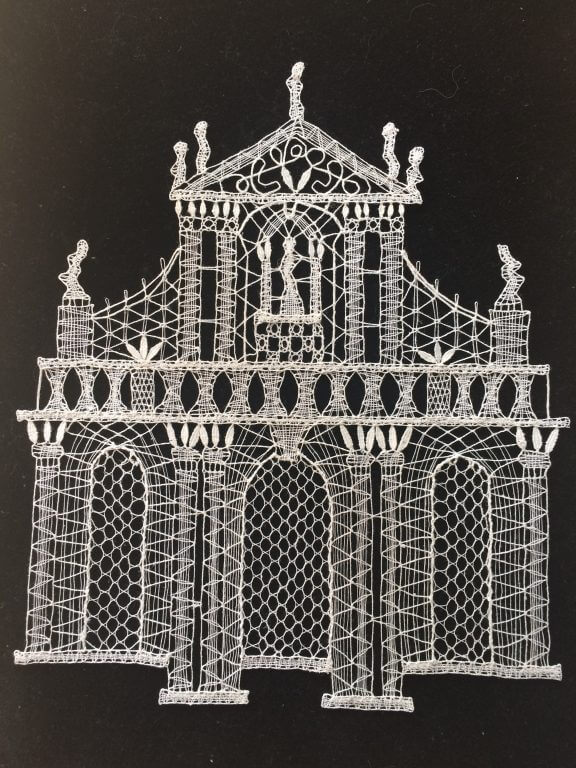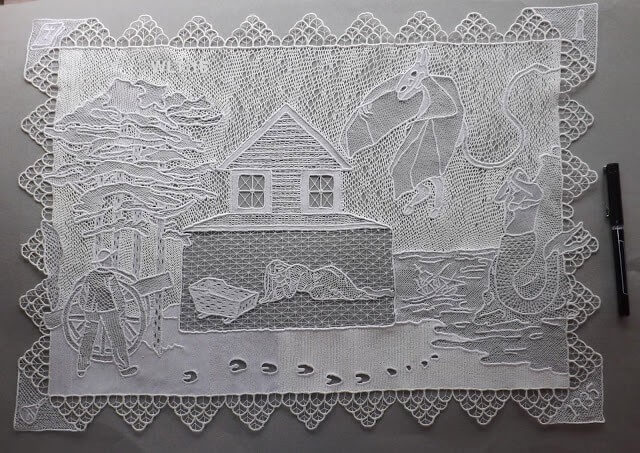The conclusion of our interview with Devon Thein, discussing Lace not Lace: Contemporary Fiber Art from Lacemaking Techniques, which opens this Sunday. You can read about the exhibition on our website.
Go here to read Part 1 of our interview.
Were there any particular challenges you’d like to mention regarding putting this show together?
One challenge is size! Lace is about miniaturization and monochrome. Lace technique evolved to fill the rapacious demand among the status conscious aristocracy for white luxury neckwear in the 16th and 17th century. This neckwear was viewed at close quarters and admired for the complexity of its design. Innovations involved finer thread, and greater complexity. Nowadays, exhibits of historical lace often include magnifying glasses hung on the wall because it is necessary to view historical lace under magnification to fully appreciate it.
The fact that the techniques and tools for lace evolved in an environment which prized a highly labor intensive, minute, single color textile makes it hard to translate bobbin and needle lace into large scale, colorful works that make for a visually exciting exhibit in a large gallery.

Milča Eremiášová, Church of San Salvador, 1974.
As a practical matter, how do you fill a large gallery with small art? How do you create a colorful exhibit using a medium that excels in monochrome? How can an artist create a large imposing work when lacemaking is so time consuming that it has been abandoned for its traditional purposes because it involves so much human labor?
The need for large colorful pieces was a challenge that was very hard to meet.
However, we are fortunate to have the first museum display ever of Lieve Jerger’s monumental Carriage of Lost Love, a life size carriage made in bobbin lace technique applied to copper wire that she has been working on for 41 years and which is still not finished.
Manca Ahlin has abandoned the traditional tools of bobbin lace, the lace pillow and bobbins in order to make two sizable works, Corona and Mani Lace Wall. These works involve putting a pattern on the floor and physically moving along it while braiding and weaving the heavy cords which are held together in a skein instead of on a bobbin.
Color is very controversial in lace. By working in color, there is a stripping of the complex patterning techniques that were used instead of color. Critics of the use of color in lace would compare it to silhouette. Does making a silhouette in color make it more interesting, or less interesting? We are fortunate to have some pieces in color that also evidence outstanding lace technique. The work of Ros Hills and Denise Watts represent the explosive use of color that characterized some of the early work of the lace revival of the 1970s. Although Hills is a needle lacemaker and Watts is a bobbin lacemaker they often collaborated and shared threads that were especially interesting. Another artist who makes use of color is Wako Ono, a Japanese artist who started out as a painter. She works in Honiton technique, an English technique, but applies principles of painting, even using gradations of color in the skirt of the Harlequin Joy.
Unfortunately, very few of the pieces that were large were colorful and very few of the pieces that were colorful were large. So, the challenge to this curator was to find enough pieces that were large, and enough pieces that had color in them to make a gallery show with overall visual impact.
For the viewer not as familiar with contemporary lace, what do you hope they will learn after seeing this exhibition?

Penny Nickels, The Jersey Devil, 2016, needle lace, 15 in. X 20 in. Courtesy of the artist.
I would like to introduce the public and the art community to needle and bobbin lace techniques, techniques that are virtually unknown outside of a small community of lacemakers. The word “lace” has come to mean anything that is white and airy. Meanwhile, art made in lace technique may not conform to this description at all. It
can be colorful and solid. I suppose I would like it if people could differentiate between the popular conception of lace as a white substance with holes, a textile that is simultaneously erotic, virginal, and grandmotherly, and the fiber art techniques that were used to construct lace historically.
Many people do not realize that lace design is not static. It always reflected the artistic aesthetic of the era in which it was made. Here is an opportunity for people to see lace that has been made in the late 20th and early 21st centuries.
I would especially like to introduce these versatile techniques to fiber artists in the hopes of inspiring more artists to work with them.
Could you pick out a particular work (or two, if you wish) and explain to someone who’s not familiar with lace, what is significant/noteworthy about it?
This show will mark the debut of Penny Nickels’ piece Jersey Devil which is exciting because there aren’t too many pieces of art that celebrate New Jersey’s unique folklore figure, the Jersey Devil. Penny Nickels spent 1,500 hours making this paean to the mythic demon of the Pine Barrens. Nickels is a former print maker who has found the principles of printmaking are transferrable to lacemaking, since both are monochromatic, and design is achieved through pattern and texture. In this piece she uses a variety of needle lace stitches to achieve different tones. Although she is not a resident of New Jersey, Nickels is interested in myths and storytelling and has meticulously researched the history of sightings of the Jersey Devil, incorporating them all into a single work. Who can resist the sight of our own state monster hovering over the stunted pines of the Pine Barrens, encouraging Mermaids to wreck ships, and dodging the cannon ball fired by Commodore Stephen Decatur? Hoof prints in the snow are proof that he has been here.